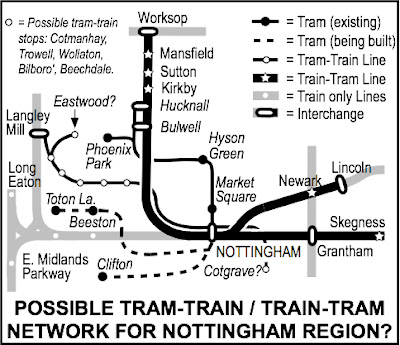The buses are not as busy as they used to be, nor are the trams as full as I expected them to be. I am not sure where the passengers have gone? Now it may be that the arrival of the tram has changed how and when people travel. I am sure it has.
What I do know is that the bus is still the best way to go into Nottingham city centre. I am assured a seat, more legroom and it will take me closer to most city centre locations. The tram wins out when it comes to the east side; Hockley, the Lace Market and the Market Square. Otherwise, bus is best and, importantly, quicker! — as my map below clearly shows.
The other disadvantage of the tram is that it serves a narrow corridor and it is relatively slow, despite the phasing of traffic lights in its favour. We hear a lot about how many people are within 800 metres of a tram stop. I am in the 'tram corridor' at the top of Wollaton Road, but this is a practical nonsense. It takes me 10 minutes to walk to Beeston Interchange and then I may have to wait another 10 minutes for a tram if I have just missed one, add on 23 minutes to the Royal Centre and a 5 minute walk to the Victoria Centre and I have a personal journey time of 48 minutes. I may also have to stand all the way on the tram and the chances of Susan and me being able to sit together are very slim.
Compare this with the minute it takes me to get to the L10 bus stop on Wollaton Road close to my home and, even allowing for it being a few minutes late (which it frequently is, but that's another story for another day), it will usually take c35 minutes at most to reach the Victoria Centre, as it is able to make up for lost time along most of its route. In other words it usually takes me 40 minutes at most by bus to do a journey which by tram would take me 48 minutes!
And so it is for countless others living in Beeston and Chilwell, but somehow there is a myth about that travelling by bus is second best, when you can be seen on a tram. Ignore the fact that your journey will take longer and, in terms of seating, be less enjoyable. There is just one tram route to the city centre from Beeston Interchange, whereas there are six bus routes, albeit two of them, my little L10 and Trent-Barton's 18 go around the houses. This still leaves four direct bus routes totalling 23 buses and hour between them (Monday–Saturday daytime), all doing the journey as quick as the tram, quicker if you take walking distances into account.
The only drawback when it comes to the buses is that there are four operators, all with their own ticketing and travel discount cards. The 'universal' Kangaroo ticket and its companion Robin Hood travelcard come at a premium price and does not (as at today) include YourBus.
The bus companies are missing a trick by failing to co-operate, but then Trent-Barton's parent company, Wellglade, has a stake in the tram, so they are hardly in competition with the tram.
For all the hype, public transport in and around Beeston and Chilwell is complicated. This is topic I have been writing about for years and I make no apologies for doing so. Public transport is a utility, like communications, energy, health, housing and water. All should be under public control. It is very easy to forget that all these things were once owned and managed by local government in many parts of England Wales and Scotland.
An excellent report, Building a world-class bus system for Britain, published last week argues for the municipalisation of public transport, saying that in its absence what we need is London style 'contracting' arrangement to remove wasteful and expensive competition. In one of several mentions of Nottinghgam, the report points out that bus companies like Trent-Barton make huge profits at our expense. I will come back to the report in a future blog. Right now I would like you to look at my map and see for yourself why the bus, despite all the tram hype, remains Beeston's most important and valuable form of public transport. Simply click on the map to enlarge.
After reading Building a world-class bus system for Britain, I revisited a report in my possession from 2011 (which you can still find on the web) arguing the 'full business case' for the tram extensions to Beeston and Clifton. It makes interesting reading and in a good few respects the vision offered is very different to the reality delivered.
Media reports all tell us that the new Chilwell and Clifton tram lines (known as 'Phase 2') cost £570 million to complete (then there are the interest payments over the next thirty years). A high-frequency bus network across the whole county could have been in place by now for a fraction of £570 million. The quality of road surfaces and reserved roadways could all have helped to improve the quality of our 'bus-ride' (a commonly cited reason for preferring the tram over the bus — the smoothness of the ride).
Again, as I have said on many occasions before, I did not oppose the tram. I bought into the arguments about park and ride, getting motorists out of their cars, reducing road congestion, that men see the tram as 'more sexy' than the bus and all too many will not abandon their cars for the latter. I can't see it myself. Such men have obviously never experienced the delights of the back bench seat on a bus, especially a late-night double-decker!
And on with that thought in my head and I will go and do Sunday lunch...









